- Home
- Terry Pratchett
Turtle Recall: The Discworld Companion ... So Far Page 5
Turtle Recall: The Discworld Companion ... So Far Read online
Page 5
In 1576, it was invited by the city’s elders to elevate its status to that of a Guild, giving it voting rights in the city’s Guild Council. It then changed its name to the Royal Guild of Assassins but, following the events of 1688, it wisely dropped the use of the ‘Royal’ from its title and restyled itself the Guild of Assassins.
Regrettably, in 1767, following a rash wager by the then head of the Guild, who believed that two pairs could beat any other hand, the freehold of the main Guild premises passed seamlessly to Sir John ‘Mad Jack’ Ramkin, and has remained in the possession of the Ramkin family until recently, when it became part of the marriage gift of Lady Sybil Ramkin to Sir Samuel Vimes, later His Grace the Duke of Ankh-Morpork, with whom the Guild has a good working relationship.
It now has the original seventy-two King’s Scholars (as they are still known) plus 180 Oppidans and a varying number of scholarship boys, the number of the latter usually decreasing as the term progresses. In this form, it has continued to grow in reputation and influence in Ankh-Morpork and throughout the known Disc. Indeed, so great is the reputation of the Guild education that a number of students now come from Klatch.
There are many stories of Assassins meeting, in the course of business, clients who themselves were ‘old boys’ of the school, and singing a few verses of the old school song together before the inhumation was completed. There have been occasions where the client, shedding tears of joy at the fact that his death would be a part of the ancient and wonderful tradition, signed over a large part of his fortune to the Guild, and many Guild scholarships and bursaries are a result of this. And of course all young Assassins know the story of Sir Bernard Selachii who, upon meeting an Assassin financed by a business rival, spent the entire evening with him, reminiscing about the great days they had shared in Wigblock House, before suggesting that they drink a toast to the old school and then, while his would-be assassin held his glass aloft, beating him to death with the brandy bottle. Subsequently, Sir Bernard endowed the Sir Bernard Selachii Award for Sheer Coolth, a much coveted prize to this day.
GUILD TRADITIONS
Stealth Chess
New members are always welcome for this exciting and taxing sport, which takes a few hours to grasp but a lifetime to master. It is an excellent test of memory and a remarkable sharpening of that most valuable of skills to an Assassin – rampant paranoia.
It has been argued that a form of Stealth Chess was the original chess; this point of view is largely based on the discovery, in an ancient tomb in Muntab, of a preserved corpse with an eight squares by ten squares chessboard embedded in its skull and a pawn hammered firmly up each nostril.
It is entirely unlike its better-known offspring in actual play, although there is only one unfamiliar type of piece. This is, of course, the Assassin.
There are two on each side, outside the Rooks, facing one another down the two outermost files of squares (coloured red and white on the Muntab board, rather than the black and white of the rest of the board). These are known as the Slurks. No other type of piece may enter these. Assassins, as they say, keep to the walls.
Strictly speaking, an Assassin moves one square in any direction, or two to capture. And it may capture any piece on the board except another Assassin – that is, a player may sometimes choose to save a usefully positioned Assassin by letting it ‘assassinate’ one of its fellow pieces in order to occupy its square but will never attack an opposing Assassin, because ours is an honourable trade.
So far, that makes it merely a powerful, if slow piece. But it is ‘movement in the Slurk’ that is the Assassin’s forte, and an exciting move it is. It is hard to believe that the ancients had any concept of the Uncertainty Principle, but in short an Assassin’s real movement in the Slurk may not necessarily be in the direction it appears to be moving in. All the piece is indicating is that it is moving, not the direction; it is moving, as the wizards may say, through another dimension. If, for example, an Assassin takes three moves in the Slurk it can on its next move reappear on any square three squares from the point where it entered and then make a one-square move to capture.
Players of the younger, conventional game find this hard to grasp and, once grasped, hard to live with as silent death appears in the middle of a classic King’s Klatchian defence and checkmates the King. Once newcomers pick up the idea, they then find that undue reliance on the powerful Assassins can be unwise if they neglect the opponent’s Queen in stately yet conventional progress down the board. Around this point they give up – but for thrills and fascination there is nothing like watching a game between two skilled players with all four Assassins in play and working invisibly with the other pieces, in an atmosphere of concentrated fear.
The acknowledged master of the game is the Patrician, Lord Havelock Vetinari, who won a Black four years running and honed his skill, or so it is said, by playing blindfold.
We can report a very successful season last year, winning all forty-eight games played (five or them by default, the opponent timing out in a terminal kind of way).
The Wall Game
To the unfamiliar, this appears to be a cross between urban rock-climbing, squash, and actual bodily harm. It is traditionally played on the walls of the Guild’s inner courtyard, but ‘friendly’ and practice games are played anywhere on Guild property when a wall has been adapted to mimic some of the original features (such as ‘Old Mother Baggy’s Washing Line’, ‘the Window Box’, ‘the Coke Heaps’, ‘the Wonky Drainpipe’, ‘the Place Where the Mortar Is Rotten’ and so on). Two teams of three per side are involved, playing with a small ball made of cork wrapped in leather bands. The rules are complex, points being scored by bouncing the ball off walls and opposing players, and only one member of any team may be below 100 inches from the ground at any time. Most games run into injury time, sometimes forever.
Pullis Corvorum
On Soul Cake Tuesday, the Guild chef catches a young magpie and attaches it to a pancake which he then nails to one of the Guild doors, incanting: ‘Pullis corvorum invocantibus eum.’ The poor bird is then worried to death by first year students. A small prize, as yet unclaimed for more than two hundred years, will go to the boy who comes up with a halfway logical explanation for this.
Chapel Snoddie
The pews nearest to the high altar are occupied by the Guild’s teaching staff. Immediately below them, the pews are reserved for the Prefects. Old Prefects by tradition leave small packets of almonds and raisins for their new colleagues. This is known as Chapel Snoddie. It is, of course, a ritualised test; anyone who would eat any old food found lying around wouldn’t last a term.
Tumpers
It quickly became a tradition for the whole Guild to process to the Tump, where the new boys would be sprinkled with salt to instil them with wit for their coming years at CS, ‘sal’ meaning both salt and wit, and puns being the lowest form of the latter. Later this became a means of raising funds for Guild charities. Every year on 12 January, boys from the school go out in pairs onto the streets of Ankh-Morpork. One carries a stoneware pot of salt, the other a leather draw-string purse. They accost passers-by and encourage them to make a donation to the Guild. When they receive money, the donor is given a pinch of salt and everyone feels embarrassed.
May Blossom Day
On May Day, if the Master of Assassins gives permission and if the day is moist, the boys are permitted to rise early and collect boughs of May blossom in Hide Park and decorate with them the windows of their dormitories. The boys are, however, not allowed to get their feet wet. For the past ninety years, no boy has bothered to give it a try.
ASSASSIN’S DRESS AND SCHOOL UNIFORM
The correct clothing for any Assassin ‘at large’ is black, and indeed many Assassins wear no other colour even in their leisure hours, although deep purples and greys will not cause comment.
Boys are not allowed to wear black in their first two years, but may ‘take dark’ some time in their third if they are making satisfactor
y progress.
Boys (under 5' 6") in their first year at the Guild must wear the New Bod uniform of a midnight blue coat and knee breeches, worn with cream waistcoat and ruffled shirt, the whole capped off with a black tricorn of beaver pelt.
New Bod Scholars wear white duck trousers instead of the knee breeches and, of course, their heavy woollen Scholars’ gown.
Boys over 5' 6" must wear all of the above plus a sheepish expression.
First and second year girls of any size must wear a black gymslip or pinafore, black woollen stockings, and round hat known as the ‘blonker’.
The purpose of these outfits is to make the pupils feel rather foolish, and hence determined to succeed in their studies and ‘take dark’ at the earliest opportunity
After ‘taking dark’, pupils are expected to dress fashionably while eschewing bright colours; young women are enjoined not to dress in a way that might unduly inflame the amorous propensities of their male colleagues. All pupils must wear the Guild’s crest on their lapel.
All pupils pursuing post-graduate studies are entitled to dress and conduct themselves as full Assassins.
Only Prefects may carry their umbrellas furled.
Apart from their stylish clothing they can also be recognised by their Guild salute – the thumb pressed against the first two fingers of the right hand and rubbed gently, the ancient sign of a man expecting to be paid. Of course, another way of recognising them is when, at dead of night, someone stabs you. That was them. Presumably someone cared enough about you to pay.
The monetary aspect is vital. The Assassins profess a great regard for the sanctity of human life, and therefore charge enormous amounts for taking it away. As they say: ‘We do not kill merely for a handful of silver. It’s a lapful of gold or nothing.’ Killing for any other reason is an absolute and unforgivable violation of Guild rules, and any Assassin discovered in breach of this rule would find himself at the very pointed end of his Guild’s displeasure. By law, they must always leave a receipt.
Incidentally, they do not kill in bulk; they offer a personal service. Even the most famous assassins never killed more than thirty people in all their lives. They would consider guns and bombs as reducing the whole thing to the level of a farce.
Astfgl. Supreme Life President of HELL. One-time King of the Demons, Lord of Hell and Master of the Pit. A Pit, in any case. Despite his undoubted power, he is, like most demons, unimaginative, single-minded and irredeemably stupid in a bureaucratic, industrious sort of way. He favours a moustache, red silk coat, crimson tights and a cowl with two rather sophisticated horns on it, plus a trident (with a loose end). Nevertheless, when he loses control of his appearance, his talons show through his red silk gloves, he sprouts bat-like wings and his skull is framed by great coiled ram horns. Demons have no specific shape and it is assumed that he chose these two forms, which show a certain amount of flair, after seeing an illustration somewhere. [E]
Astrolabe. One of the Disc’s finest astrolabes is kept in a large, star-filled room in KRULL. It includes the entire Great A’Tuin-Elephant-Disc system wrought in brass and picked out with tiny jewels. Around it the stars and planets wheel on fine silver wires. On the walls the constellations have been made of tiny phosphorescent seed pearls set out on vast tapestries of jet-black velvet. These were, of course, the constellations current at the time of the room’s decoration – several would be unrecognisable now owing to the Turtle’s movement through space. The planets are minor bodies of rock picked up and sometimes discarded by the system as it moves through space, and seem to have no other role in Discworld astronomy or astrology than to be considered a bloody nuisance. [COM]
Astrozoologists. Krullian scientists interested in studying the nature of the Great A’TUIN. Specifically, its sex. [ COM ]
Atavarr’s Personal Gravitational Upset. Little-used and hard-to-master spell used by GARHARTRA against Rincewind. It makes the body believe that gravity is acting at right angles to the norm. [COM]
A’Tuin, the Great. The star turtle who carries the Discworld on its back. Ten-thousand-mile-long member of the species Chelys galactica, and the only turtle ever to feature on the Hertzsprung-Russell Diagram. Almost as big as the Disc it carries. Sex unknown.
Shell-frosted with frozen methane, pitted with meteor craters and scoured with asteroidal dust, its eyes are like ancient seas, crusted with rheum. Its brain is the size of a continent, through which thoughts move like glittering glaciers.
It is as large as worlds. As patient as a brick. Great A’Tuin is the only creature in the entire universe that knows exactly where it is going.
Upon its back stand Berilia, Tubul, Great T’Phon and Jerakeen, the four giant elephants upon whose shoulders the disc of the world rests. A tiny sun and moon spin around them on a complicated orbit to induce seasons, although probably nowhere else in the multiverse is it sometimes necessary for an elephant to cock its leg to allow the sun to go past.
After the events of The Light Fantastic, the Great A’Tuin was orbited by eight baby turtles, each with four small world-elephant calves and tiny discworlds, covered in smoke and volcanoes. They have subsequently begun their own cosmic journeys.
Wizards have tried to tune into Great A’Tuin’s mind. They trained up on tortoises and giant sea turtles to get the hang of the Chelonian mind. But although they knew that the Great A’Tuin’s mind would be big, they rather foolishly hadn’t realised it would be slow. After thirty years all they found out was that the Great A’Tuin was looking forward to something.
People have asked: How does the Disc move on the shoulders of the elephants? What does the Turtle eat? One may as well ask: What kind of smell has yellow got? It is how things are.
Auditors of Reality. It has to be understood that the universe of the Discworld is almost entirely animistic. Everything is conscious at some level. The level of reality in the vicinity of the Disc is so low that the distance between the real and the imagined is very small and, frequently, non-existent (hence the de facto existence of such beings as the HOGFATHER, OLD MAN TROUBLE, the TOOTH FAIRIES and the SOUL CAKE TUESDAY DUCK). On the Discworld, even thunderstorms can think.
It follows – at least, it follows on Discworld – that this inherent consciousness should turn up even at the most basic of levels, such as those involving the very physics of the universe. These are therefore policed by the Auditors of Reality, a race of non-individualised beings whose job it is to make sure the universe functions properly and doesn’t just do what it likes. If you travelled faster than light, it is quite possible that it is they who would fine you for speeding.
In appearance they look like small grey empty robes, with a cowl (when they adopt human form, they favour clothing in shades of . . . grey). They act entirely on consensus; they hate and distrust individuality, which for them is instantly fatal.
It is clear that they regard life itself as being unnecessary, untidy, and contrary to good order. The whole purpose of the universe, they know, is to gradually wind down; it is not right, they are sure, that bits of it should wake up and ask questions like ‘What’s going on?’ or grow petals or fly around singing. They are not life-forms. They are non-life-forms. The observers of the Universe. Its clerks. They see to it that things spin and rocks fall. They hate questions. They hate them almost as much as they hate decisions and they hate decisions almost as much as they hate the idea of the individual personality. But what they hate most of all is things moving around randomly. They believe that for a thing to exist it has to have a position in time and space. Humanity has arrived as a nasty shock. Humanity practically is things that don’t have a position in time and space, such as imagination, pity, hope, history and belief. Intelligent life is an anomaly. The Auditors really hate things like that.
They can see into human minds. They can see the pop and sizzle of the thoughts. But they cannot read them. They can see the energetic flow from node to node, they can see the brain glittering like a Hogswatch decoration. What they can’t see
is what is happening.
One of their greatest enemies is DEATH, partly because as immortals they fear death far more than humans do (they are like high-stakes gamblers with everything to lose) and partly because of his tendency to tip the scales of history very slightly in favour of humanity. After all, Death more than anyone else depends on the existence of life. It is his living. They avoid death by never going so far as to get a life. They strive to be as indistinguishable as hydrogen atoms, with none of the latter’s ‘joie de vivre’.
Aurora corialis. (See also Aurora coriolis). The Hublights. Great curtains of cold fire whose frosty tints illuminate and colour the midnight snows with silent streamers of OCTARINE, blue and green from the roof of the world. Caused by the vast discharge of magic from the Disc’s standing field earthing itself in the green ice mountains of the Hub.
Autocondimentor. Someone who will put certainly salt and probably pepper on any meal you put in front of them whatever it is and regardless of how much it’s got on it already and regardless of how it tastes. These people really exist (even on Earth) and fast-food empires have saved millions by recognising their existence. Mustrum RIDCULLY is such a one; in fact he is one of the extreme variety, who regards any meal as no more than a foundation for salt, pepper, mustard, pickles, ketchup and sauce. [RM]
Azrael. The Great Attractor, the Death of Universes, the Beginning and End of Time.
He is DEATH’S master, although it is uncertain whether Death is a truly separate entity or merely one aspect of the whole. He is a creature so large that in real space his length can be measured only in terms of the speed of light. On his dark, sad face his eyes are so big a supernova would be a mere suggestion of a gleam on the iris. He is also keeper of the ultimate clock, from which all TIME originates. Other clocks tell what time it is – but the ultimate clock tells Time what it is. [RM]
Bad Ass. Village in the kingdom of LANCRE in the RAMTOPS. Not a large village, and it wouldn’t show up on a map of the mountains. It barely shows up on a map of the village. This is a small community, close-knit to the point of a trawlerman’s sock, where front doors are used only by brides and corpses and back doors are always left unlocked.

 Feet of Clay
Feet of Clay The Color of Magic
The Color of Magic Thud!
Thud! Good Omens: The Nice and Accurate Prophecies of Agnes Nutter, Witch
Good Omens: The Nice and Accurate Prophecies of Agnes Nutter, Witch I Shall Wear Midnight
I Shall Wear Midnight Mort
Mort Raising Steam
Raising Steam Guards! Guards!
Guards! Guards!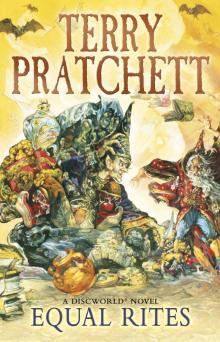 Equal Rites
Equal Rites A Hat Full of Sky
A Hat Full of Sky The Light Fantastic
The Light Fantastic Mrs Bradshaw's Handbook
Mrs Bradshaw's Handbook Wyrd Sisters
Wyrd Sisters Soul Music
Soul Music Small Gods
Small Gods Sourcery
Sourcery Reaper Man
Reaper Man Night Watch
Night Watch Lords and Ladies
Lords and Ladies The Fifth Elephant
The Fifth Elephant Monstrous Regiment
Monstrous Regiment The Truth
The Truth Witches Abroad
Witches Abroad Eric
Eric Going Postal
Going Postal Men at Arms
Men at Arms Jingo
Jingo The Amazing Maurice and His Educated Rodents
The Amazing Maurice and His Educated Rodents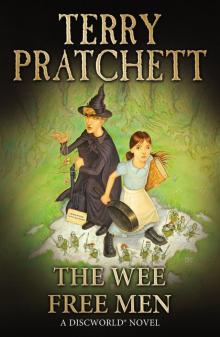 The Wee Free Men
The Wee Free Men Pyramids
Pyramids Wintersmith
Wintersmith Moving Pictures
Moving Pictures Carpe Jugulum
Carpe Jugulum Interesting Times
Interesting Times Maskerade
Maskerade Making Money
Making Money The Shepherd's Crown
The Shepherd's Crown Hogfather
Hogfather Troll Bridge
Troll Bridge The Last Continent
The Last Continent The Sea and Little Fishes
The Sea and Little Fishes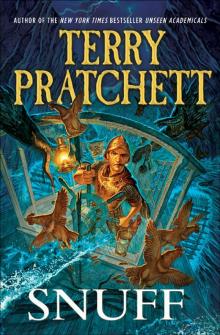 Snuff
Snuff Unseen Academicals
Unseen Academicals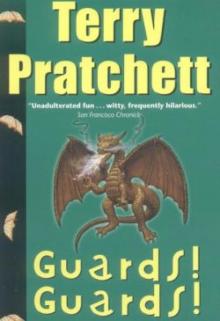 Guards! Guards! tds-8
Guards! Guards! tds-8 Jingo d-21
Jingo d-21 Turtle Recall: The Discworld Companion ... So Far
Turtle Recall: The Discworld Companion ... So Far The Fifth Elephant d-24
The Fifth Elephant d-24 Discworld 39 - Snuff
Discworld 39 - Snuff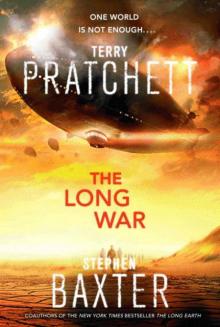 The Long War
The Long War Only You Can Save Mankind
Only You Can Save Mankind The Science of Discworld III - Darwin's Watch tsod-3
The Science of Discworld III - Darwin's Watch tsod-3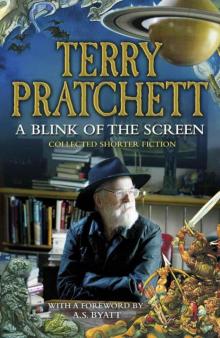 A Blink of the Screen: Collected Short Fiction
A Blink of the Screen: Collected Short Fiction Unseen Academicals d-37
Unseen Academicals d-37 Wings
Wings Making Money d-36
Making Money d-36 A Blink of the Screen
A Blink of the Screen Johnny and the Bomb
Johnny and the Bomb Dodger
Dodger Strata
Strata Discworld 02 - The Light Fantastic
Discworld 02 - The Light Fantastic The Folklore of Discworld
The Folklore of Discworld The Science of Discworld
The Science of Discworld The Unadulterated Cat
The Unadulterated Cat Raising Steam: (Discworld novel 40) (Discworld Novels)
Raising Steam: (Discworld novel 40) (Discworld Novels) The World of Poo
The World of Poo Discworld 05 - Sourcery
Discworld 05 - Sourcery The Witch's Vacuum Cleaner: And Other Stories
The Witch's Vacuum Cleaner: And Other Stories The Science of Discworld II - The Globe tsod-2
The Science of Discworld II - The Globe tsod-2 Small Gods: Discworld Novel, A
Small Gods: Discworld Novel, A Men at Arms tds-15
Men at Arms tds-15 Tama Princes of Mercury
Tama Princes of Mercury The Last Hero (the discworld series)
The Last Hero (the discworld series) The Long Utopia
The Long Utopia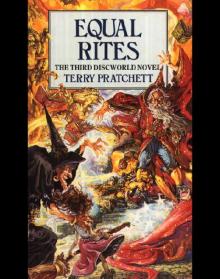 Discworld 03 - Equal Rites
Discworld 03 - Equal Rites Terry Pratchett - The Science of Discworld
Terry Pratchett - The Science of Discworld The Long Earth
The Long Earth The Carpet People
The Carpet People The Sea and Little Fishes (discworld)
The Sea and Little Fishes (discworld)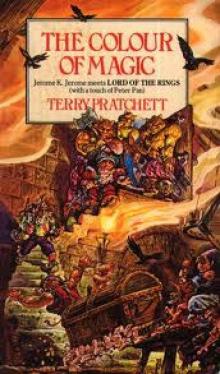 The Colour of Magic
The Colour of Magic Discworld 16 - Soul Music
Discworld 16 - Soul Music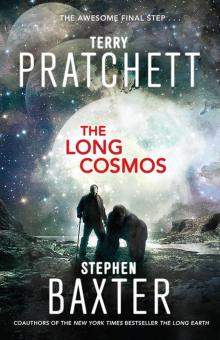 The Long Cosmos
The Long Cosmos The Dark Side of the Sun
The Dark Side of the Sun Monstrous Regiment tds-28
Monstrous Regiment tds-28 The Bromeliad 3 - Wings
The Bromeliad 3 - Wings Dragons at Crumbling Castle: And Other Stories
Dragons at Crumbling Castle: And Other Stories Night Watch tds-27
Night Watch tds-27 The Science of Discworld I tsod-1
The Science of Discworld I tsod-1 The Bromeliad 1 - Truckers
The Bromeliad 1 - Truckers The Science of Discworld Revised Edition
The Science of Discworld Revised Edition The Abominable Snowman
The Abominable Snowman Father Christmas’s Fake Beard
Father Christmas’s Fake Beard The Bromeliad Trilogy
The Bromeliad Trilogy A Slip of the Keyboard
A Slip of the Keyboard The Wee Free Men d(-2
The Wee Free Men d(-2 Johnny and the Dead
Johnny and the Dead Mrs Bradshaw's Handbook (Discworld Novels)
Mrs Bradshaw's Handbook (Discworld Novels) Truckers
Truckers The Amazing Maurice and His Educated Rodents d(-1
The Amazing Maurice and His Educated Rodents d(-1 Diggers
Diggers Thief of Time tds-26
Thief of Time tds-26 Science of Discworld III
Science of Discworld III Dragons at Crumbling Castle
Dragons at Crumbling Castle Nation
Nation Darwin's Watch
Darwin's Watch Interesting Times d-17
Interesting Times d-17 The Bromeliad 2 - Diggers
The Bromeliad 2 - Diggers The Science of Discworld II
The Science of Discworld II